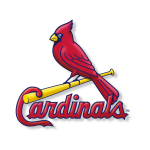Feature Photo: Harrison Bader, CF, Cardinals
This week I profile Cardinals center fielder Harrison Bader, the Cardinals’ 2015 third-rounder who is a plus defender with a hit tool that could profile near the top of the Cardinals’ lineup in the near future. I was also able to view a start by the Card’s 2014 first-rounder Luke Weaver (RHP) on June 28 versus the Oklahoma City Dodgers, and he appears to be knocking on the door of the big leagues as a future mid-rotation piece for St. Louis.
Meanwhile up in Pawtucket, I got my first look at Chance Adams (RHP, Yankees), who is making quick work of the Yankees’ farm system. I viewed his start on July 2 versus the Pawtucket Red Sox, and while he possesses the raw stuff to get major league hitters out, he may have more impact in a relief role for the Bronx Bombers than as a starting pitcher.
.
2080 Prospect Spotlights
 Harrison Bader, CF, Cardinals (Triple-A Memphis, Pacific Coast League)
Harrison Bader, CF, Cardinals (Triple-A Memphis, Pacific Coast League)
Ht/Wt: 6’0”/195 lbs. B/T: R/R Age (as of April 1st 2017): 22y 10m
With the Cardinals 25-man roster in flux, the rapid ascension of the 2015 third-rounder could soon help ease the pressure the St. Louis front office is under to find consistent contributions from their outfield corps. While Bader isn’t an overly projectable physically, he is a plus athlete and packs significant strength into his six-foot-tall frame. He is very quiet at the plate with very little wasted movement and an extremely short path to the ball. He has a level plane, and brings average raw power generating excellent carry to the big part of the field thanks to above-average bat speed. While his over-the-fence pop is mainly to the pull side, he has more than enough juice to drive the right-center field gap. Bader’s power fell off a little bit when he was promoted to Triple-A in 2016, but the .216 ISO he posted in 356 Double-A plate appearances that year is proving to be no fluke – he has adjusted well in 2017 (his first full season at Triple-A) and posted a .199 ISO mark through 315 plate appearances this year.
While Bader is not a true five-tool prospect, he will pressure the defense and hit to the situation — he gets on base (career .347 OBP, and .356 this year), but is not passive at the dish and is aggressive in the zone. That said, the 24.3% strikeout rate and 5.7% walk rate he’s posted thus far in 2017 are indicators that those OBP numbers won’t hold up versus big league pitching – his hands are very quick and it is tough to beat him inside, however he can get overly aggressive with two strikes and will chase. However, the ingredients are there for him to reverse those trends as he continues to develop in the pro game. When he does go outside his zone at the plate, it seems more a result of him trying to do too much and trying to hit pitches that he can’t square up rather than a lack of pitch recognition, or being overmatched. The swing mechanics are so compact and efficient that as his approach matures, he should start to get more selective and be able to cut back on the swing and miss.
A plus defender in center field, Bader has above-average range into the gaps and does an excellent job closing in on balls hit in front of him. The arm strength is fringe average, however his accuracy is quite good and plays up the arm to an average grade.
Bader has the offensive weapons to hit anywhere in the Cardinals’ lineup – however his doubles-type power and plus run tool make him a potentially ideal fit towards the top of the order. Going forward, I would expect Bader to be able to make the necessary adjustments to his approach and eventually be a high-average hitter as well. Much like A.J. Pollock (CF, Diamondbacks), Bader brings a nice set of tools on both sides of the baseball, and should bring impact to a big league roster as a solid everyday guy.
 Luke Weaver, RHP, Cardinals (Triple-A Memphis, Pacific Coast League)
Luke Weaver, RHP, Cardinals (Triple-A Memphis, Pacific Coast League)
Ht/Wt: 6’2”/170 lbs. B/T: R/R Age (as of April 1st 2017): 23y, 10m
A PCL All-Star in his first full season at the Triple-A level, Weaver is pounding the table to be recalled to St. Louis to help the big club in the second half. While Weaver has once again shown plus control and solid average command, his improved slider and the feel he’s now showing with the changeup are inspiring signs that he will be able to knock back the high contact rates that plagued him in his 2016, when he gave up 11.4 H/9 in his first taste of the big leagues. He currently sits at 6.6 H/9 through 56 Triple-A innings in 2017, his lowest mark of any pro stop where he’s thrown more than 20 innings. In years past, Weaver has struggled to locate anything to the glove side – his crossfire delivery, while adding deception, works against his ability to extend, and the slider (until recently) lacked much depth and has played as more of a cutter. While his misses still tend to be to the arm side and the breaking balls will back up on him at times, the slider he ‘s presently throwing features greater depth and late bite, giving him a weapon that is off the usual plane of his heater. While consistency is still an issue, he is overmatching Triple-A bats, and will soon need to test his adjustments at the next level.
This is not to say that Weaver’s success depends solely on the slider — he still has a 60-grade heater that sits in the middle 90s (T97), along with a 60-grade circle changeup that bottoms out and is a real weapon versus lefties. He is wirey strong and is a tremendous athlete, and while there is some effort in his delivery, he is able to throttle up and back well with a bit of an extra gear in big spots. The fly balls are still a bit of a concern (0.96 GO:AO ratio), but Weaver is a strike thrower and doesn’t walk many (2.1 BB/9). If he can continue to improve his command to the glove side of the dish and miss a few more barrels, he should see the traffic on the bases clear up. Should that happen, the Cardinals could be looking at a guy capable of turning over a big league lineup more than a couple times and holding down a spot in the middle of that rotation.
Ed Note: Weaver was promoted to the Cardinals, and made his MLB Debut July 3, throwing a scoreless inning of relief while allowing two hits.
 Chance Adams, RHP, Yankees (Triple-A Scranton/Wilkes-Barre, Int’l League League)
Chance Adams, RHP, Yankees (Triple-A Scranton/Wilkes-Barre, Int’l League League)
Ht/Wt: 6’1”/210 lbs. B/T: R/R Age (as of April 1st 2017): 22y 8m
Drafted in the fifth round of the 2015 MLB Draft, Adams has wasted no time establishing himself as one of the top pitching prospects in the Yankees’ system. The compact, muscular right-hander brings a plus fastball (91-to-96 mph) to the table along with two potentially average secondary offerings. The slider can bring some 3/4’s depth but it can get shallow at times and act like more of a cutter, but he has shown a few of late with some significant depth and bite that has helped lead to a nice run of 43 strikeouts over his last six starts. Adams does have a bit of a hard-hard profile, and the firm changeup, while having decent velocity separation, has more fade to the arm side than any real bottom, causing it to stay on plane with the fastball and be hittable.
Adams has a very quick arm through his high-3/4’s slot, and the heater gets plus life in the zone. Adams does have some effort in his delivery, but he’s athletic enough to repeat it while doing a good job creating angle to the plate. Despite the even GO:AO ratio in 2017, his heater does have some heft to it and if his command in the zone improves, he should start to see more ground balls – a point that could make the difference between him sticking in the rotation and moving to the bullpen. Thus far in his pro career, Adams has been tough to square up, and he hasn’t posted a H/9 total higher than 6.1 as a pro. His command is below average, however, and his walk rates are hovering around 3.50 BB/9 across two levels this season – two things that will be exploited at the next level should he not make some improvements. However, the quality of his raw stuff can’t be discounted, and it will play versus major league hitters – the question will be how consistently can he locate, and will he be able to change speeds enough to keep hitters off the hard-hard profile multiple times through the order.
Ultimately, the below-average command and the walk rate will bite him at the next level, where he won’t be able to over-match hitters out over the plate. The changeup is a nice pitch and the way his arm works, it is not a stretch to think that he will find some feel as his approach on the bump matures — but right now it is a fringe-average pitch for him, and not a real weapon versus lefties. For him to be expected to turn over lineups two and three times per outing, he will need that three-pitch mix. As it stands, he’s more likely to debut in the Bronx as a bullpen piece, where he can go hard for an inning or two. As the value of late-inning power arms grow, the seventh and eighth inning might be the place where Adams has the most impact for the Yankees, as opposed to a number four starter, where the command would get exposed.


